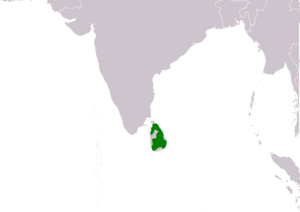Chestnut-backed owlet facts for kids
Quick facts for kids Chestnut-backed owlet |
|
|---|---|
 |
|
| Conservation status | |
| Scientific classification | |
| Genus: |
Glaucidium
|
| Species: |
castanotum
|
 |
|
| Range of G. castanotum Resident | |
| Synonyms | |
|
Glaucidium radiatum castanonotum |
|
The chestnut-backed owlet (Glaucidium castanotum) is a small owl. It lives only in Sri Lanka, meaning it is endemic to that country. This owl is part of a larger group of owls called typical owls, or Strigidae. This family includes most of the smaller owl species. The chestnut-backed owlet was once thought to be a type of jungle owlet.
What Does It Look Like?
The chestnut-backed owlet is a small and chubby bird. It is about 19 cm (7.5 in) long. It looks a lot like the jungle owlet in its shape and size. However, its upper body, shoulders, and wing feathers are mostly chestnut brown. These parts also have darker stripes.
Its belly is white with dark streaks. The feathers around its face are mostly brown. It has bright yellow eyes. There is also a white band around its neck. Male and female owlets look the same.
Where Does It Live?
The chestnut-backed owlet is a common bird in the wet forests of Sri Lanka. You can easily spot it in places like Kitulgala and Sinharaja.
A long time ago, this owl lived in many parts of southern Sri Lanka. This included the hills and the wet lowlands near Colombo. Today, its home has become much smaller. It now lives only in the remaining wet zone forests. You can find it in the nearby hills, up to about 6,500 ft (2,000 m) above sea level.
How Does It Behave?
This owl is active during the day, especially in the evening. Its flight is wavy, going up and down. You can often find it by listening for small birds. These birds will gather around the owl and make a lot of noise when it is sitting in a tree. This is called "mobbing."
The chestnut-backed owlet often sits on top of tall trees. It prefers trees on steep hillsides, which makes it hard to spot. It mainly eats insects, like beetles. But it also catches mice, small lizards, and small birds. It does this more often when it is feeding its young.
The owl's call is a slow "kraw-kraw." This sound can travel a long distance. It builds its nest in a hole in a tree. The female owl usually lays two eggs.
In Sri Lankan Culture
In Sri Lanka, this bird has a special name. It is known as Pitathabala Vana-Bassa. In the Sinhala language, this is written as පිටතඔල වන බස්සා.


